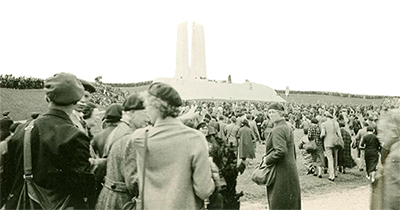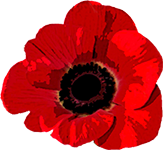
|

|

|
Vimy Ridge, April 9-12, 1917
Many consider Canada's involvement in the victory of Vimy Ridge in Northern France a defining moment in Canadian history. The success of the Canadian troops at the Ridge earned a solid reputation for their heroic efforts despite the many thousands who lost their lives.
The French had failed in their attack on the Ridge and the Canadian Corps were ordered to seize Vimy Ridge. Ramped up preparations and training as well as a vast system of trenches that had been constructed enabled troops to travel more safely to and from the 'front'. The trenches were used for transporting wounded soldiers and supplies, they housed field hospitals, listening posts, supply caches and areas for troops to rest in. Barbed-wire barricades were a major obstacle during the war as they were difficult to get through and very hard to destroy from any distance. Late in 1916, the British came up with a design for the first instantaneous percussion artillery and using French technology, the new Number 106 fuze enabled shells to explode on contact with whatever they met. The Canadians used the fuses on the barbed-wire barricades which were effectively destroyed allowing troops and equipment to gain ground. Hill 145 is the highest and most important feature of the Ridge and it is where Canadian Walter Seymour Allward's monument to peace, the Canadian National Vimy Memorial (unveiled in 1936), now stands in remembrance "to the valour of their countrymen in the Great War and in memory of their sixty thousand dead this monument is raised by the people of Canada.”
Vimy Ridge Pilgrimage - Unveiling July 26, 1936
 Vimy Ridge Monument Unveiling 1936A special pilgrimage for the unveiling ceremony of the monument was planned for July 26, 1936. The Canadian Government issued over 6,000 Special Vimy Passports free to people who wanted to attend. Five ships were used to transport pilgrims to France for the unveiling and specially planned memorial events. One ship carried 300 wreaths which were to be laid at Canadian sites on the Western Front battlefields.
Vimy Ridge Monument Unveiling 1936A special pilgrimage for the unveiling ceremony of the monument was planned for July 26, 1936. The Canadian Government issued over 6,000 Special Vimy Passports free to people who wanted to attend. Five ships were used to transport pilgrims to France for the unveiling and specially planned memorial events. One ship carried 300 wreaths which were to be laid at Canadian sites on the Western Front battlefields.
His Majesty King Edward VIII and Monsieur Albert Lebrun, President of France, participated in the unveiling and 100,000 pilgrims including British and French ex-servicemen, family members and friends were invited to attend the ceremonies. The Canadian pilgrims included approximately 8,000 veterans, including their friends and family.
 Florida(left), Arnold(center), Gladys(right)Among those Canadians was veteran Arnold Sutcliffe, his wife Florida Mae Arnold Sutcliffe, and her daughter, Gladys M. Arnold, the first (and only) Canadian journalist in France at the start of World War II).
Florida(left), Arnold(center), Gladys(right)Among those Canadians was veteran Arnold Sutcliffe, his wife Florida Mae Arnold Sutcliffe, and her daughter, Gladys M. Arnold, the first (and only) Canadian journalist in France at the start of World War II).
For more information on Gladys M. Arnold see University of Regina Archives and Special Collections Fonds 89-61, 98-54, 2005-12, 2007-42, 2009-71, 2010-21, 2011-34, 2012-11 and 2013-14 at Gladys M. Arnold Finding Aids.

|

|

|
